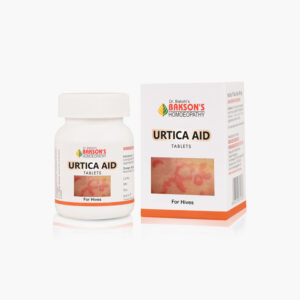What is Urticaria?
The term urticaria has been derived from a common European stinging nettle, Urtica dioica. It is a condition characterised by itchy weal (hives), with or without surrounding erythematous flares. A wheal (weal) is a typical superficial skin-coloured or pale skin swelling, usually surrounded by erythema that lasts from few minutes to 24 hours.
The current classification of urticaria may be defined as: –
Acute spontaneous urticaria: Spontaneous occurrence of wheals and/or angioedema for a total duration of fewer than six weeks.
Chronic spontaneous urticaria (CSU): Spontaneous occurrence of wheals and/or angioedema for a total duration of six weeks or more. This is synonymous with “chronic urticaria” and “chronic idiopathic urticaria.”
Chronic inducible urticaria (CIndU): Occurrence of wheals for a total duration of six weeks or more, which is inducible by physical factors (e.g., touch, pressure extremes). This is synonymous with “physical urticaria”
There is a strong female preponderance, affecting women twice as often as men. The prevalence of urticaria is higher in the age group of 40 to 60 years.
Aetiology
The exact cause of urticaria is unknown. A hypothesis suggests that it relates to autoimmune dysfunction involving autoantibodies. Certain autoimmune disorders like hypothyroidism (most common), rheumatoid arthritis, celiac disease and type-1 diabetes mellitus are related to the condition. Foods and additives can also cause acute urticaria due to IgE-mediated food allergy.
Sign and symptoms
Urticaria and angioedema result from the activation of mast cells and basophils. It is characterized by pruritic pink-to-red papules and plaques that can vary in size and shape as they coalesce together, typically with central pallor. Wheal remains for less than 24 hours without any residual ecchymosis or pigmentation.
On skin examination, excoriations and erosions may be present as a result of scratching.
Angioedema may be present in some subjects that is characterised by subcutaneous or submucosal oedema affecting areas like lips, periorbital, genitals and extremities.
Diagnosis
It is important to elicit the history of the patient to determine exacerbating factors and to exclude differential diagnoses including any family or personal history of allergies and autoimmune diseases.
The routine laboratory investigation for urticaria includes complete blood count and inflammatory markers like C-reactive protein, ESR etc.
General management
The mainstay of the management of urticaria is avoiding the exacerbating factors and the symptomatic control through pharmacological interventions.
Warning: Above information provided is an overview of the disease, we strongly recommend a doctor’s consultation to prevent further advancement of disease and/or development of complications.
Disclaimer: The information provided herein on request, is not to be taken as a replacement for medical advice or diagnosis or treatment of any medical condition. DO NOT SELF MEDICATE. PLEASE CONSULT YOUR PHYSICIAN FOR PROPER DIAGNOSIS AND PRESCRIPTION.



 Login
Login






